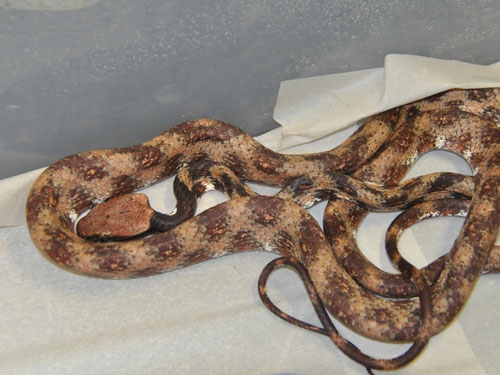| Citation |
|
Description |
Geographic Range [top]
Range Description: Until recently, specimen-based records of this species were only known from Quang Binh Province, central Viet Nam (Tillack et al. 2004). There are at least three additional records from Kom Tum Province to the south, from sites between 500 and 1,500 m asl. (Ziegler et al. 2010). This snake may occur throughout the area of intact karst limestone of central and north-central Viet Nam and adjacent Lao PDR (R. Bain pers. comm.), and may also extend into remaining forested areas of northeastern Cambodia (T. Neang pers. comm. 2011); however until this can be confirmed the extent of occurrence is here treated as the combined area of known localities, an area of approximately 3,385 km².
Countries occurrence:
Native:
Viet Nam
Additional data:
? Number of Locations: 3
? Lower elevation limit (metres): 500
? Upper elevation limit (metres): 1500
Range Map: Click here to open the map viewer and explore range.
Population [top]
Population: No information is available on population trends in this species. Surveys have been conducted at and between the known sites, however very few specimens of this snake are known (Ziegler et al. 2010).
Current Population Trend: Unknown
Additional data:
? Population severely fragmented: Unknown
Habitat and Ecology [top]
Habitat and Ecology: The type specimen of this species was found in the leaf-litter of primary evergreen forest in a rocky valley of the Annamite mountains at 550 m above sea level (Tillack et al. 2004). Snakes in this genus are primarily tree-dwellers that are nocturnally active, lay eggs and feed on small vertebrates. Specimens from Kom Tum were found at night in mixed secondary forest of trees and bamboo. So far, all specimens recorded were discovered at night time on the forest floor, on forest paths, or on rocks, but never in branches. All records have been taken near streams in rocky environments. The species can be found in forests associated with both granite and karst.
Systems: Terrestrial
Continuing decline in area, extent and/or quality of habitat: Yes
Use and Trade [top]
Use and Trade: No data are available on trade in this poorly-known snake. There is however limited commercial demand for this species, and trade is not thought to represent a threat (Q.T. Nguyen pers. comm. 2011).
Threats [top]
Major Threat(s): This species may be in decline due to the loss, fragmentation and degradation of its forest habitat as a result of logging and the expansion of agriculture. In Lao PDR land use change and deforestation have reduced the forest cover of the country by 30% between the 1940s and 1999 (Foppes and Ketphanh 2000), although in both Lao PDR and Viet Nam large areas of forest remain.
Conservation Actions [top]
Conservation Actions: There are no species-specific conservation measures in place for this species. There are protected areas within this species suspected range, including Phong Nha-Ke Bang National Park in Viet Nam (Ziegler et al. 2006). Further research into the population trends, habitat, threats, distribution, and ecology of this species are needed. Surveys are needed in adjacent areas of Cambodias Mondolkiri Province, including Virachey National Park, to establish whether this snake occurs in that country (T. Neang pers. comm. 2011). Protection of additional forest may be required, and efforts to limit further deforestation are recommended.
Citation: Thy, N., Nguyen, T.Q., Ananjeva, N.B., Orlov, N.L., Golynsky, E. & Bain, R. 2012. Boiga bourreti. The IUCN Red List of Threatened Species 2012: e.T176620A1441655. http://dx.doi.org/10.2305/IUCN.UK.2012-1.RLTS.T176620A1441655.en. Downloaded on 28 January 2019.
Disclaimer: To make use of this information, please check the .
Feedback: If you see any errors or have any questions or suggestions on what is shown on this page, please provide us with feedback so that we can correct or extend the information provided
|

